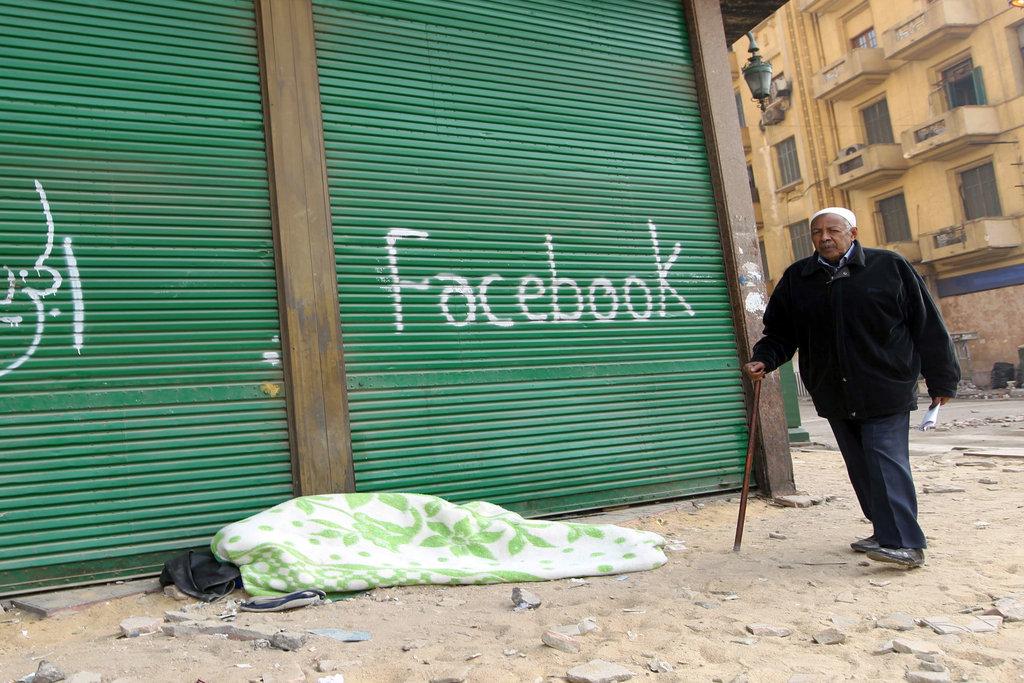Egypt’s ‘digital activism’ hits its limit
An Egyptian anti-government demonstrator sleeps on the pavement under graffiti that reads ‘Al-Jazeera’ and ‘Facebook’ at Cairo’s Tahrir square on February 7, 2011 on the 14th day of protests calling for the ouster of President Hosni Mubarak.
CAIRO — For decades, Arab dictators have monopolized information flow, employing state media to propagate the official line while censoring independent media. But in recent years new alternatives, including satellite TV and internet platforms have expanded the scope of media consumption in the Arab world, and with it the scope of political expression.
In Egypt, digital activism was born with the explosion of the blogosphere early in the 21st century. The internet emerged as a platform for citizens to publish views in a public sphere away from the eyes of media censors. With restrictions tight on mainstream media, activists moved to the newer digital platform where red lines were blurry. Egyptian bloggers started to tackle sensitive issues such as police torture and sexual harassment on the web, where there was a larger margin for freedom.
Then January 25, 2011 created millions of revolutionaries. For 18 days, a myriad of faces poured into the streets, because they saw the ambitious call for “Revolution” on Facebook, or the #Jan25 hashtag on Twitter, or simply joined the chanting hundreds marching underneath their windows. But after Mubarak was out of the picture, Egyptian society reverted back to the pre-revolutionary landscape: digital activists on one side and brainwashed, pro-stability state media watchers on the other.
Across the Arab world, social media has helped shape a more pluralistic media scene, providing an alternative narrative to national media, which remain plagued with one-sided regime rhetoric. The youth population dominates Internet use — 62 percent of Egyptian Facebook users are under 25 years old — and has become the driving force behind political reform.
Government agendas can no longer be spoon fed, unchallenged, to masses of passive spectators. Gradually, a dynamic and diverse cyberspace has encouraged Arab citizens to make up their minds on their own.
The series of Arab uprisings that kicked off in Tunisia, closely followed by Egypt’s revolution, were organized and covered by social media. Revolting over decades of media censorship and a stifled political landscape, digital activists helped assemble civic action, ultimately transcending red lines and agitating change in countries once deemed hopelessly stagnant.
But a gap has emerged between the educated and the illiterate, the tech-savvy youth and older, “Internet what?” generation. This gap pervades Egyptian society today, with the population fragmented along the lines of their varying media consumptions.
Post-February 11, when the common goal that transcended media and moved to the streets was achieved with Mubarak’s ouster, the gap was reinstated and the fragmentation all the clearer.
And in the state of transition that “new Egypt” is now witnessing, social media has become “revolution central” while state media remains loyal to the ruling military regime.
Is the country divided beyond repair?
Exemplifying this fragmented arena is the most recent attacks on peaceful protesters at the sit-in of Egypt’s Cabinet, which started on December 16. A state media blackout on December 17 ensured that the only way to get information, other than state TV, was via Twitter, Facebook and YouTube.
These platforms showed eyewitness accounts of army soldiers beating and killing protesters and setting Tahrir Square on fire. In an attempt to find out what was happening in Tahrir on the 17th, I wanted to open Twitter on my browser. I accidentally typed in “Tahrir.com” instead — a telling mistake.
Meanwhile, state TV continued to propagate counter-protesters’ messages.
But an extraordinary example of bridging the digital gap materialized on December 18. While many people on the streets still condemned the protesters, and claimed that photos of military brutality were “Photoshopped” (interesting bridge of digital divide right there, don’t you think?), activists and journalists on Twitter were calling for a grassroots awareness effort.
Deena Adel, also a GlobalPost-Open Hands Initiative “Covering a Revolution” fellow tweeted: “It's time for us to take this off Twitter. We're screaming & shouting only amongst ourselves. Nobody's listening cuz we're not telling them.”
Next, a group of activists and citizen journalists started printing photos of the attacks and setting up screens in Cairo and Alexandria to broadcast the other side of the story — the revolutionary side of it.
As we approach the anniversary of the January 25 revolution, the people are divided, and the media is certainly not helping. Despite the dynamism of Egyptian media today, old habits die hard. State TV still counters the revolution, and it sometimes seems that digital actors are screaming into a vacuum. The revolution, which arguably started online, remains online, disconnected from the masses and now failing to generate offline support.
The story you just read is accessible and free to all because thousands of listeners and readers contribute to our nonprofit newsroom. We go deep to bring you the human-centered international reporting that you know you can trust. To do this work and to do it well, we rely on the support of our listeners. If you appreciated our coverage this year, if there was a story that made you pause or a song that moved you, would you consider making a gift to sustain our work through 2024 and beyond?
